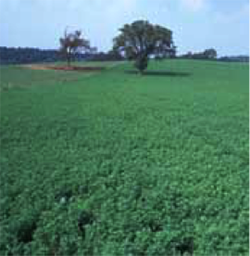Timely Tip: Grazing Alfalfa after a Freeze
 A frost or freeze can greatly affect how one uses alfalfa later in the year. Although frost-damaged alfalfa is not toxic, one should be cautious when grazing alfalfa after a hard freeze (less than 25˚F) as the threat of bloat increases after the freeze. Once wilting starts, risk of bloat is reduced. Waiting a few days after a freeze is a good practice to decrease this risk when grazing alfalfa. If forage is needed and you plan to cut alfalfa for hay late in the year, cut after the first hard freeze or in early to mid-November. Even without a freeze there is very little regrowth after this date. After a hard freeze occurs, cut as soon as possible to reduce losses in nutritive value.
A frost or freeze can greatly affect how one uses alfalfa later in the year. Although frost-damaged alfalfa is not toxic, one should be cautious when grazing alfalfa after a hard freeze (less than 25˚F) as the threat of bloat increases after the freeze. Once wilting starts, risk of bloat is reduced. Waiting a few days after a freeze is a good practice to decrease this risk when grazing alfalfa. If forage is needed and you plan to cut alfalfa for hay late in the year, cut after the first hard freeze or in early to mid-November. Even without a freeze there is very little regrowth after this date. After a hard freeze occurs, cut as soon as possible to reduce losses in nutritive value.
If cutting or grazing after a non-killing frost during late September or October, plants can start to regrow and will use stored carbohydrates. These carbohydrate reserves would otherwise be used for overwintering and spring regrowth and, without the reserves, the life of the alfalfa stand could be compromised.
Categories:
Fall
Forage Related Disorders


